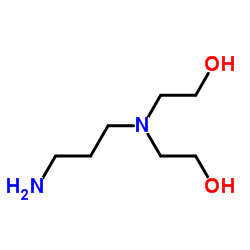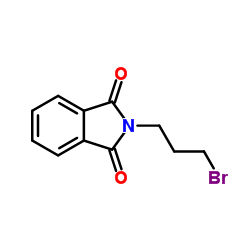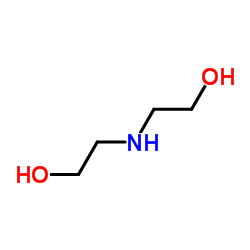4985-85-7
| Name | N-(3-Aminopropyl)diethanolamine |
|---|---|
| Synonyms |
ethanol, 2,2'-((3-aminopropyl)imino)bis-
N,N-Bis(2-hydroxyethyl)-1,3-propanediamine N,N-Bis(2-hydroxyethyl)-1,3-diaminopropane N,N-Di(2-hydroxyethyl)-1,3-propanediamine 2,2'-((3-Aminopropyl)imino)diethanol 2-[3-aminopropyl(2-hydroxyethyl)amino]ethanol MFCD00047971 2,2'-[(3-Aminopropyl)imino]diethanol EINECS 225-642-0 2,2'-((3-aminopropyl)imino)bisethanol N-(3-Aminopropyl)diethanolamine Ethanol, 2,2'-[(3-aminopropyl)imino]bis- |
| Density | 1.1±0.1 g/cm3 |
|---|---|
| Boiling Point | 316.5±22.0 °C at 760 mmHg |
| Molecular Formula | C7H18N2O2 |
| Molecular Weight | 162.230 |
| Flash Point | 145.2±22.3 °C |
| Exact Mass | 162.136826 |
| PSA | 69.72000 |
| LogP | -1.07 |
| Vapour Pressure | 0.0±1.5 mmHg at 25°C |
| Index of Refraction | 1.509 |
|
N-(3-Aminopropyl)diethanolamine
Revision number: 1
SAFETY DATA SHEET Section1. BASE INFORMATION Product name:N-(3-Aminopropyl)diethanolamine Revision number:1 Section2. HAZARDS IDENTIFICATION Classification of the GHS PHYSICAL HAZARDSNot classified HEALTH HAZARDS Category 1C Skin corrosion/irritation Serious eye damage/eye irritationCategory 1 Not classified ENVIRONMENTAL HAZARDS GHS label elements Pictograms or hazard symbols Signal wordDanger Hazard statementCauses severe skin burns and eye damage Precautionary statements [Prevention]Do not breathe. Wash hands thoroughly after handling. Wear protective gloves/eye protection/face protection. [Response]IF INHALED: Remove victim to fresh air and keep at rest in a position comfortable for breathing. IF SWALLOWED: Rinse mouth. Do NOT induce vomiting. IF IN EYES: Rinse cautiously with water for several minutes. Remove contact lenses, if present and easy to do. Continue rinsing. IF ON SKIN (or hair): Remove/Take off immediately all contaminated clothing. Rinse skin with water/shower. Wash contaminated clothing before reuse. Immediately call a POISON CENTER or doctor/physician. Store locked up. [Storage] [Disposal]Dispose of contents/container through a waste management company authorized by the local government Section3. COMPOSITION/INFORMATION ON INGREDIENTS Substance/mixture:Substance Component(s):N-(3-Aminopropyl)diethanolamine >90.0%(GC) Percent: CAS Number:4985-85-7 N,N-Bis(2-hydroxyethyl)-1,3-diaminopropane Synonyms: Chemical Formula:C7H18N2O2 N-(3-Aminopropyl)diethanolamine Section4. FIRST AID MEASURES Inhalation:Remove victim to fresh air and keep at rest in a position comfortable for breathing. Immediately call a POISON CENTER or doctor/physician. Skin contact:Remove/Take off immediately all contaminated clothing. Gently wash with plenty of soap and water. Immediately call a POISON CENTER or doctor/physician. Eye contact:Rinse cautiously with water for several minutes. Remove contact lenses, if present and easy to do. Continue rinsing.Immediately call a POISON CENTER or doctor/physician. Ingestion:Immediately call a POISON CENTER or doctor/physician. Rinse mouth. Do NOT induce vomiting. burning sensation, difficulty in breathing, thirst, asthma, nausea, vomiting, bronchitis , Symptoms/effects: diarrhoea, weakness, collapse, headache, redness, pain, burn A rescuer should wear personal protective equipment, such as rubber gloves and air- Protection of first-aiders: tight goggles. Section5. FIRE-FIGHTING MEASURES Suitable extinguishingDry chemical, foam, water spray, carbon dioxide. media: Extinguishing media not to Solid streams of water be used: Specific hazards:Take care as it may decompose upon combustion or in high temperatures to generate poisonous fume. Specific methods:Fire-extinguishing work is done from the windward and the suitable fire-extinguishing method according to the surrounding situation is used. Uninvolved persons should evacuate to a safe place. In case of fire in the surroundings: Remove movable containers if safe to do so. Special protectiveWhen extinguishing fire, be sure to wear personal protective equipment. equipment for firefighters: Section6. ACCIDENTAL RELEASE MEASURES Personal precautions,Use extra personal protective equipment (self-contained breathing apparatus). Keep protective equipment and people away from and upwind of spill/leak. Ensure adequate ventilation. Entry to non- emergency procedures: involved personnel should be controlled around the leakage area by roping off, etc. Environmental precautions: Prevent product from entering drains. Methods and materials for Absorb spilled material in a suitable absorbent (e.g. rag, dry sand, earth, saw-dust). containment and cleaning In case of large amount of spillage, contain a spill by bunding. Adhered or collected up: material should be promptly disposed of, in accordance with appropriate laws and regulations. Section7. HANDLING AND STORAGE Handling Technical measures:Handling is performed in a well ventilated place. Wear suitable protective equipment. Prevent generation of vapor or mist. Wash hands and face thoroughly after handling. Use a closed system if possible. Use a ventilation, local exhaust if vapor or aerosol will be generated. Advice on safe handling:Avoid contact with skin, eyes and clothing. Storage Storage conditions:Keep container tightly closed. Store in a cool and dark place. Store under inert gas. Protect from moisture. Store locked up. Store away from incompatible materials such as oxidizing agents. Law is followed. Packaging material: Section8. EXPOSURE CONTROLS / PERSONAL PROTECTION Engineering controls:Install a closed system or local exhaust. Also install safety shower and eye bath. N-(3-Aminopropyl)diethanolamine Section8. EXPOSURE CONTROLS / PERSONAL PROTECTION Personal protective equipment Respiratory protection: Half or full facepiece respirator, self-contained breathing apparatus(SCBA), supplied air respirator, etc. Use respirators approved under appropriate government standards and follow local and national regulations. Hand protection:Impervious gloves. Safety goggles. A face-shield, if the situation requires. Eye protection: Skin and body protection: Impervious protective clothing. Protective boots, if the situation requires. Section9. PHYSICAL AND CHEMICAL PROPERTIES Physical state (20°C):Liquid clear Form: Color:Colorless - Slightly pale yellow Ammoniacal Odor: pH: 12 Melting point/freezing point:No data available Boiling Point/Range:207 °C Flash Point:138°C Explosive limits No data available Lower: Upper:No data available 5.6 Vapor Density: Density:1.07 Soluble in : Water Solubility: Section10. STABILITY AND REACTIVITY Stability:Stable under proper conditions. Reactivity:No special reactivity has been reported. Conditions to avoid:Hygroscopic Incompartible materials: oxidizing agents, acids Hazardous Decomposition Carbon monoxide, Carbon dioxide, Nitrogen oxides (NOx) Products: Section11. TOXICOLOGICAL INFORMATION No data available Acute Toxicity: Skin corrosion/irritation: No data available No data available Serious eye damage/irritation: Germ cell mutagenicity: No data available Carcinogenicity: No data available IARC = NTP =No data available No data available Reproductive toxicity: Section12. ECOLOGICAL INFORMATION Ecotoxicity: Fish:No data available Crustacea:No data available Algae:No data available Persistence / degradability: No data available BioaccumulativeNo data available potential(BCF): Mobillity in soil log Pow:No data available Soil adsorption (Koc):No data available Henry's LawNo data available constant(PaM3/mol): N-(3-Aminopropyl)diethanolamine Section13. DISPOSAL CONSIDERATIONS Recycle to process, if possible. Consult your local regional authorities. You may be able to burn in a chemical incinerator equipped with an afterburner and scrubber system. Observe all federal, state and local regulations when disposing of the substance. Section14. TRANSPORT INFORMATION Hazards Class:8: Corrosive. UN-No:2735 Polyamines, liquid, corrosive, n.o.s. Proper shipping name: Packing group:III Section15. REGULATORY INFORMATION Safe management ordinance of dangerous chemical product (State Council announces on January 26, 2002): Safe use and production, the storage of a dangerous chemical, transport, loading and unloading were prescribed. SECTION 16 - ADDITIONAL INFORMATION N/A |
| Hazard Codes | Xi: Irritant; |
|---|---|
| Risk Phrases | R34 |
| Safety Phrases | S26-S36/37/39 |
| RIDADR | 2735 |
| Packaging Group | III |
| Hazard Class | 8 |
| HS Code | 2922199090 |
|
~32% 
4985-85-7 |
| Literature: Jocher, Christoph; Pape, Tania; Hahn, F. Ekkehardt Zeitschrift fur Naturforschung - Section B Journal of Chemical Sciences, 2005 , vol. 60, # 6 p. 667 - 672 |
|
~79% 
4985-85-7 |
| Literature: Asseline, Ulysse; Chassignol, Marcel; Draus, Jolanta; Durand, Maurice; Maurizot, Jean-Claude Bioorganic and Medicinal Chemistry, 2003 , vol. 11, # 16 p. 3499 - 3511 |
|
~% 
4985-85-7 |
| Literature: Wingfoot Corp. Patent: US2368521 , 1942 ; |
|
~% 
4985-85-7 |
| Literature: Ledochowski,A. et al. Roczniki Chemii, 1969 , vol. 43, # 5 p. 1083 - 1087 |
| HS Code | 2922199090 |
|---|---|
| Summary | 2922199090. other amino-alcohols, other than those containing more than one kind of oxygen function, their ethers and esters; salts thereof. VAT:17.0%. Tax rebate rate:13.0%. . MFN tariff:6.5%. General tariff:30.0% |





